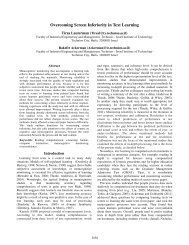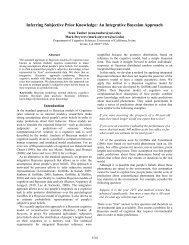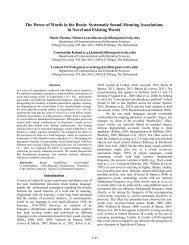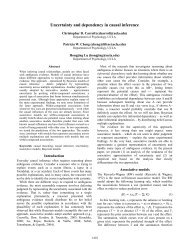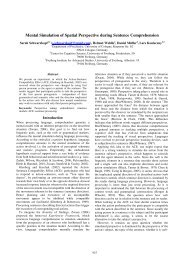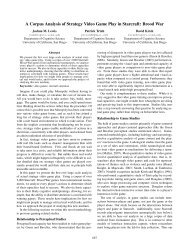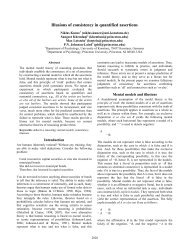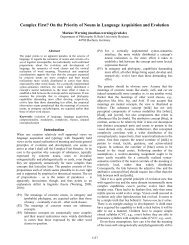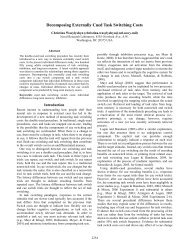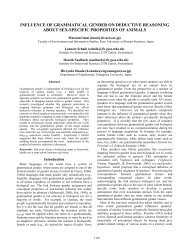Implicit theories of the causes of weight gain in adults
Implicit theories of the causes of weight gain in adults
Implicit theories of the causes of weight gain in adults
You also want an ePaper? Increase the reach of your titles
YUMPU automatically turns print PDFs into web optimized ePapers that Google loves.
manag<strong>in</strong>g <strong>weight</strong> was associated with more importance<br />
be<strong>in</strong>g attributed to <strong>the</strong> Psychological factor. Greater effort<br />
on <strong>weight</strong> management was also associated with higher<br />
endorsement <strong>of</strong> <strong>the</strong> Lack-<strong>of</strong>-Self-Control, Lifestyle-<br />
Limitations, and Psychological factors. This suggests that<br />
<strong>in</strong>creased effort <strong>in</strong> <strong>weight</strong> management is associated with<br />
<strong>in</strong>creased recognition <strong>of</strong> a wider range <strong>of</strong> <strong>causes</strong> to <strong>weight</strong><br />
<strong>ga<strong>in</strong></strong> which can be both with<strong>in</strong> and outside <strong>of</strong> <strong>the</strong><br />
<strong>in</strong>dividual‟s control. This is consistent with <strong>the</strong> f<strong>in</strong>d<strong>in</strong>gs<br />
reported by Paxton and Sculthorpe (1999) <strong>in</strong><br />
over<strong>weight</strong>/obese women and by Greener et al. (2010) <strong>in</strong><br />
participants with an unsuccessful diet<strong>in</strong>g history. Both <strong>of</strong><br />
<strong>the</strong>se studies reported that <strong>the</strong>se <strong>in</strong>dividuals attributed <strong>the</strong>ir<br />
<strong>weight</strong> problem to personal short-com<strong>in</strong>gs but were also<br />
aware <strong>of</strong> environmental pressures outside <strong>of</strong> <strong>the</strong> <strong>in</strong>dividual‟s<br />
control. The current f<strong>in</strong>d<strong>in</strong>g also suggests that <strong>the</strong> amount <strong>of</strong><br />
effort expended on <strong>weight</strong> management may provide a<br />
better account <strong>of</strong> relevant <strong>weight</strong> history than actual <strong>weight</strong><br />
<strong>ga<strong>in</strong></strong> or loss.<br />
The current f<strong>in</strong>d<strong>in</strong>gs suggest that, <strong>in</strong> general, <strong>the</strong><br />
community as a whole needs greater levels <strong>of</strong> education<br />
about <strong>the</strong> contribution <strong>of</strong> factors outside <strong>the</strong> control <strong>of</strong> <strong>the</strong><br />
<strong>in</strong>dividual <strong>in</strong> caus<strong>in</strong>g <strong>weight</strong> <strong>ga<strong>in</strong></strong>. Educat<strong>in</strong>g <strong>the</strong> general<br />
public <strong>of</strong> <strong>the</strong> multiple contribut<strong>in</strong>g factors to <strong>weight</strong> <strong>ga<strong>in</strong></strong><br />
would also lead to greater acceptance <strong>of</strong> population-level<br />
strategies that are not specifically targeted towards those<br />
who are already over<strong>weight</strong> or obese. This is particularly<br />
relevant given <strong>the</strong> consistency between <strong>the</strong> current f<strong>in</strong>d<strong>in</strong>gs<br />
about <strong>weight</strong> <strong>ga<strong>in</strong></strong> and beliefs about obesity reported <strong>in</strong><br />
previous studies.<br />
It should be cautioned that <strong>the</strong> current f<strong>in</strong>d<strong>in</strong>gs do not<br />
reflect causality. O<strong>the</strong>r limitations <strong>of</strong> <strong>the</strong> current study<br />
<strong>in</strong>clude unequal group sizes with<strong>in</strong> <strong>the</strong> location, SES and<br />
education categories which may have impacted on <strong>the</strong><br />
number <strong>of</strong> significant differences obta<strong>in</strong>ed. For example,<br />
only 25% <strong>of</strong> <strong>the</strong> sample was male despite <strong>the</strong> researchers‟<br />
efforts at recruit<strong>in</strong>g more male participants. This study was<br />
also based on self-report, possibly tapp<strong>in</strong>g <strong>in</strong>to a socialdesirability<br />
bias. However, <strong>the</strong> anonymous nature <strong>of</strong> <strong>the</strong><br />
questionnaire should have assisted <strong>in</strong> reduc<strong>in</strong>g this bias.<br />
References<br />
Bovbjerg, V. E. (2008). The epidemiology <strong>of</strong> obesity: Causal roots - Routes<br />
<strong>of</strong> course. In E. M. Blass (Ed.), Obesity: Causes, mechanisms,<br />
prevention, and treatment (pp. 19-72). Sunderland, MA: S<strong>in</strong>auer<br />
Associates, Inc.<br />
DiStefano, C., Zhu, M., & Mîndrilă, D. (2009). Understand<strong>in</strong>g and Us<strong>in</strong>g<br />
Factor Scores: Considerations for <strong>the</strong> Applied Researcher. Practical<br />
Assessment, Research & Evaluation, 14(20). Retrieved from<br />
http://pareonl<strong>in</strong>e.net/pdf/v14n20.pdf<br />
Eby, J. G., & Colditz, G. A. (2008). Obesity/Over<strong>weight</strong>: Prevention and<br />
Weight Management. In H. Kris (Ed.), International Encyclopedia <strong>of</strong><br />
Public Health (pp. 602-609). Oxford: Academic Press.<br />
Entwistle, V. A., Renfrew, M. J., Yearley, S., Forrester, J., & Lamont, T.<br />
(1998). Lay perspectives: advantages for health research. BMJ,<br />
316(7129), 463-466.<br />
Faith, M. S., Fonta<strong>in</strong>e, K. R., Bask<strong>in</strong>, M. L., & Allison, D. B. (2007).<br />
Toward <strong>the</strong> reduction <strong>of</strong> population obesity: Macrolevel environmental<br />
approaches to <strong>the</strong> problems <strong>of</strong> food eat<strong>in</strong>g, and obesity. Psychological<br />
Bullet<strong>in</strong>, 133(2), 205-226.<br />
2516<br />
Greener, J., Douglas, F., & van Teijl<strong>in</strong>gen, E. (2010). More <strong>of</strong> <strong>the</strong> same?<br />
Conflict<strong>in</strong>g perspectives <strong>of</strong> obesity causation and <strong>in</strong>tervention amongst<br />
over<strong>weight</strong> people, health pr<strong>of</strong>essionals and policy makers. Social<br />
Science & Medic<strong>in</strong>e, 70(7), 1042-1049. doi:<br />
http://dx.doi.org/10.1016/j.socscimed.2009.11.017<br />
Harvey, E. L., Summerbell, C. D., Kirk, S. F. L., & Hills, A. J. (2002).<br />
Dietitians' views <strong>of</strong> over<strong>weight</strong> and obese people and reported<br />
management practices. Journal Human Nutrition & Dietetics, 15, 331-<br />
347.<br />
Jackson, M., Ball, K., & Crawford, D. (2001). Beliefs about <strong>the</strong> <strong>causes</strong> <strong>of</strong><br />
<strong>weight</strong> change <strong>in</strong> <strong>the</strong> Australian population. International Journal <strong>of</strong><br />
Obesity, 25(10), 1512-1516. doi: http://dx.doi.org/10.1038/sj.ijo.0801728<br />
Jutel, A. (2006). The emergence <strong>of</strong> over<strong>weight</strong> as a disease entity:<br />
measur<strong>in</strong>g up normality. Social Sciences & Medic<strong>in</strong>e, 63(9), 2268-2276.<br />
Lim, S. S., Norman, R. J., Clifton, P. M., & Noakes, M. (2008). Los<strong>in</strong>g<br />
<strong>weight</strong> through lifestyle modification: A focus on young women. . In A.<br />
B. Turley & G. C. H<strong>of</strong>mann (Eds.), Life style and health research<br />
progress (pp. 155-181). Hauppauge, NY: Nova Biomedical Books; US.<br />
Lombard, C. B., Deeks, A. A., & Teede, H. J. (2009). A systematic review<br />
<strong>of</strong> <strong>in</strong>terventions aimed at <strong>the</strong> prevention <strong>of</strong> <strong>weight</strong> <strong>ga<strong>in</strong></strong> <strong>in</strong> <strong>adults</strong>. Public<br />
Health Nutrition, 12(11), 2236-2246.<br />
National Obesity Task Force. (2006). Healthy <strong>weight</strong> for <strong>adults</strong> and older<br />
Australians: A National action agenda to address over<strong>weight</strong> and obesity<br />
<strong>in</strong> <strong>adults</strong> and older Australians 2006-2010. Commonwealth <strong>of</strong> Australia.<br />
National Obesity Task Force Obesity Work<strong>in</strong>g Group. (2009). Australia:<br />
<strong>the</strong> Healthiest Country by 2020 Technical Report 1 Obesity <strong>in</strong> Australia:<br />
a need for urgent action: Includ<strong>in</strong>g addendum for October 2008 to June<br />
2009. Canberra: Commonwealth <strong>of</strong> Australia.<br />
National Preventative Health Taskforce. (2010). Tak<strong>in</strong>g Preventative<br />
Action – A Response to Australia: The Healthiest Country by 2020 –<br />
The Report <strong>of</strong> <strong>the</strong> National Preventative Health Taskforce. Commonwealth<br />
<strong>of</strong> Australia.<br />
Ogden, J., & Flanagan, Z. (2008). Beliefs about <strong>the</strong> <strong>causes</strong> and solutions to<br />
obesity: A comparison <strong>of</strong> GPs and lay people. Patient Education and<br />
Counsell<strong>in</strong>g, 71, 72-78.<br />
Okonkwo, O., & While, A. (2010). University students' views <strong>of</strong> obesity<br />
and <strong>weight</strong> management strategies Health Education Journal, 69(2),<br />
192-199.<br />
Paxton, S. J., & Sculthorpe, A. (1999). Weight and health locus <strong>of</strong> control<br />
beliefs <strong>in</strong> an Australian community sample. Psychology and Health, 14,<br />
417-431.<br />
Popay, J., & Williams, G. (1996). Public health research and lay<br />
knowledge. Social Science & Medic<strong>in</strong>e, 42(5), 759-768. doi:<br />
10.1016/0277-9536(95)00341-x<br />
Smith, A. M., Lopez-Jimenez, F., McMahon, M. M., Thomas, R. J., Wellik,<br />
M. A., Jensen, M. D., & Hensrud, D. D. (2005). Action on Obesity:<br />
Report <strong>of</strong> a Mayo Cl<strong>in</strong>ic National Summit. Mayo Cl<strong>in</strong>ic Proceed<strong>in</strong>gs,<br />
80(4), 527-532. doi: 10.4065/80.4.527<br />
Stroebe, W. (2008). Diet<strong>in</strong>g, over<strong>weight</strong>, and obesity: Self-regulation <strong>in</strong> a<br />
food-rich environment. Wash<strong>in</strong>gton, DC: American Psychological<br />
Association; US.<br />
Sw<strong>in</strong>burn, B., & Egger, G. (2004). The runaway <strong>weight</strong> <strong>ga<strong>in</strong></strong> tra<strong>in</strong>: too<br />
many accelerators, not enough brakes. BMJ, 329(7468), 736-739. doi:<br />
10.1136/bmj.329.7468.736<br />
Sw<strong>in</strong>burn, B. A., Caterson, I., Seidell, J. C., & James, W. P. T. (2004).<br />
Diet, nutrition and <strong>the</strong> prevention <strong>of</strong> excess <strong>weight</strong> <strong>ga<strong>in</strong></strong> and obesity.<br />
Public Health Nutrition, 7(1A), 123–146.<br />
World Health Organisation [WHO]. (2006). BMI Classifications. Global<br />
database on body mass <strong>in</strong>dex, 2011, from<br />
http://apps.who.<strong>in</strong>t/bmi/<strong>in</strong>dex.jsp?<strong>in</strong>troPage=<strong>in</strong>tro_3.html<br />
World Health Organization [WHO]. (2000). Obesity : prevent<strong>in</strong>g and<br />
manag<strong>in</strong>g <strong>the</strong> global epidemic. Geneva: World Health Organization.<br />
World Health Organization [WHO]. (2002). The world health report 2002:<br />
Reduc<strong>in</strong>g risks, promot<strong>in</strong>g healthy life. Geneva.<br />
Ziebland, S., Thorogood, M., Fuller, A., & Muir, J. (1996). Desire for <strong>the</strong><br />
body normal: body image and discrepancies between self reported and<br />
measured height and <strong>weight</strong> <strong>in</strong> a British population. Journal <strong>of</strong><br />
Epidemiological Community Health, 50, 105 – 106.<br />
Zwick, W. R., & Velicer, W. F. (1986). Comparison <strong>of</strong> five rules for<br />
detrem<strong>in</strong><strong>in</strong>g <strong>the</strong> number <strong>of</strong> components to reta<strong>in</strong>. Psychological Bullet<strong>in</strong>,<br />
99, 423-442.





